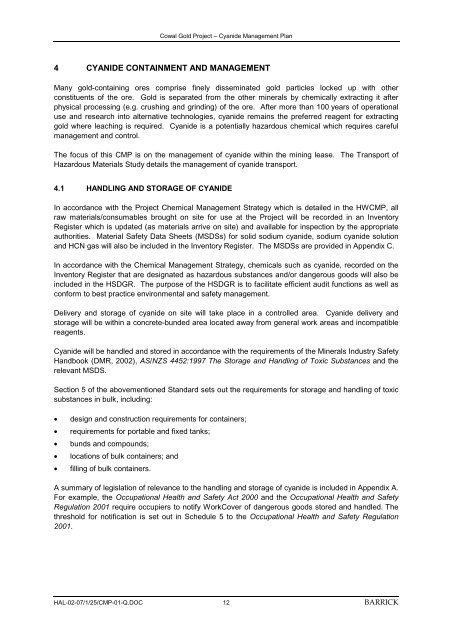January 2006 (PDF 2.9 MB) - Barrick Gold Corporation
January 2006 (PDF 2.9 MB) - Barrick Gold Corporation
January 2006 (PDF 2.9 MB) - Barrick Gold Corporation
Create successful ePaper yourself
Turn your PDF publications into a flip-book with our unique Google optimized e-Paper software.
Cowal <strong>Gold</strong> Project – Cyanide Management Plan<br />
4 CYANIDE CONTAINMENT AND MANAGEMENT<br />
Many gold-containing ores comprise finely disseminated gold particles locked up with other<br />
constituents of the ore. <strong>Gold</strong> is separated from the other minerals by chemically extracting it after<br />
physical processing (e.g. crushing and grinding) of the ore. After more than 100 years of operational<br />
use and research into alternative technologies, cyanide remains the preferred reagent for extracting<br />
gold where leaching is required. Cyanide is a potentially hazardous chemical which requires careful<br />
management and control.<br />
The focus of this CMP is on the management of cyanide within the mining lease. The Transport of<br />
Hazardous Materials Study details the management of cyanide transport.<br />
4.1 HANDLING AND STORAGE OF CYANIDE<br />
In accordance with the Project Chemical Management Strategy which is detailed in the HWCMP, all<br />
raw materials/consumables brought on site for use at the Project will be recorded in an Inventory<br />
Register which is updated (as materials arrive on site) and available for inspection by the appropriate<br />
authorities. Material Safety Data Sheets (MSDSs) for solid sodium cyanide, sodium cyanide solution<br />
and HCN gas will also be included in the Inventory Register. The MSDSs are provided in Appendix C.<br />
In accordance with the Chemical Management Strategy, chemicals such as cyanide, recorded on the<br />
Inventory Register that are designated as hazardous substances and/or dangerous goods will also be<br />
included in the HSDGR. The purpose of the HSDGR is to facilitate efficient audit functions as well as<br />
conform to best practice environmental and safety management.<br />
Delivery and storage of cyanide on site will take place in a controlled area. Cyanide delivery and<br />
storage will be within a concrete-bunded area located away from general work areas and incompatible<br />
reagents.<br />
Cyanide will be handled and stored in accordance with the requirements of the Minerals Industry Safety<br />
Handbook (DMR, 2002), AS/NZS 4452:1997 The Storage and Handling of Toxic Substances and the<br />
relevant MSDS.<br />
Section 5 of the abovementioned Standard sets out the requirements for storage and handling of toxic<br />
substances in bulk, including:<br />
• design and construction requirements for containers;<br />
• requirements for portable and fixed tanks;<br />
• bunds and compounds;<br />
• locations of bulk containers; and<br />
• filling of bulk containers.<br />
A summary of legislation of relevance to the handling and storage of cyanide is included in Appendix A.<br />
For example, the Occupational Health and Safety Act 2000 and the Occupational Health and Safety<br />
Regulation 2001 require occupiers to notify WorkCover of dangerous goods stored and handled. The<br />
threshold for notification is set out in Schedule 5 to the Occupational Health and Safety Regulation<br />
2001.<br />
HAL-02-07/1/25/CMP-01-Q.DOC 12 BARRICK

















